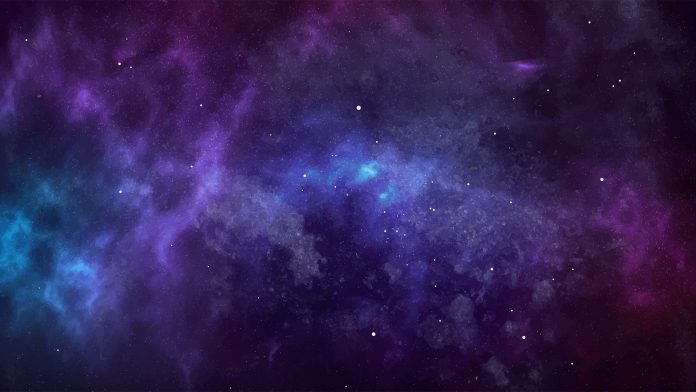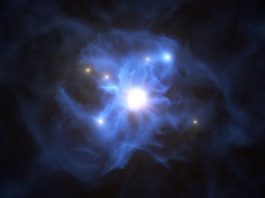Astronomers at University of California, Riverside, have utilised simulations to uncover how elusive ultradiffuse galaxies are born.
Ultradiffuse galaxies (UDGs) are dwarf galaxies whose stars are stretched over an immense area of space, leading to incredibly low surface brightness, and thus making them extremely difficult to detect. The composition of ultradiffuse galaxies raises several significant questions, such as how did these dwarfs end up so extended? Do their dark matter halos — the halos of invisible matter surrounding the galaxies — have special properties?
Detecting ultradiffuse galaxies
To answer these major astronomical questions, an international group of researchers, led by Laura Sales, an astronomer from the University of California, Riverside, have utilised advanced simulations to identify ‘quenched’ ultradiffuse galaxies (galaxies that do not form stars) in low-density environments in the Universe.
The team’s research findings have been published in Nature Astronomy.
“What we have detected is at odds with theories of galaxy formation since quenched dwarfs are required to be in clusters or group environments in order to get their gas removed and stop forming stars,” explained Sales. “But the quenched UDGs we detected are isolated. We were able to identify a few of these quenched UDGs in the field and trace their evolution backwards in time to show they originated in backsplash orbits.”
With the phrase “in the field”, Sales is referring to galaxies isolated in quieter environments and not in a group or cluster environment. She explained that a backsplash galaxy is an object that looks like an isolated galaxy today but in the past was a satellite of a more massive system, like a comet, which visits our sun periodically, but spends most of its journey in isolation, far from most of the solar system.
“Isolated galaxies and satellite galaxies have different properties because the physics of their evolution is quite different,” she continued. “These backsplash galaxies are intriguing because they share properties with the population of satellites in the system to which they once belonged, but today they are observed to be isolated from the system.”
Dwarf galaxies and UDGs
Dwarf galaxies are small galaxies comprising between 100 million to a few billion stars. Contrasting this, the Milky Way encompasses approximately 200 billion to 400 billion stars. While all ultradiffuse galaxies are dwarf galaxies, not all dwarf galaxies are UDGs. For example, at similar luminosity, dwarfs exhibit an incredibly substantial range of sizes, from compact to diffuse. Ultradiffuse galaxies are the tail end of most extended objects at a given luminosity. A UDG has the stellar content of a dwarf galaxy, 10 to 100 times smaller than the Milky Way. However, its size is similar to the Milky Way, giving it the exceptionally low surface brightness that makes it special.
Sales explained that the dark matter halo of a dwarf galaxy has a mass at least 10 times smaller than the Milky Way, and the size scales similarly. Ultradiffuse galaxies, on the other hand, contradict this rule and exhibit a radial extension comparable to that of much larger galaxies.
“One of the popular theories to explain this was that UDGs are ‘failed Milky Ways,’ meaning they were destined to be galaxies like our own Milky Way but somehow failed to form stars,” said José A. Benavides, a graduate student at the Institute of Theoretical and Experimental Astronomy in Argentina and the first author of the research paper. “We now know that this scenario cannot explain all UDGs. So theoretical models are arising where more than one formation mechanism may be able to form these ultradiffuse objects.”
Using simulations to heighten understanding
According to Sales, the value of the new work is twofold. First, the simulation applied by the team, known as TNG50, effectively predicted UDGs with characteristics like detected ultradiffuse galaxies. Next, the group discovered a few rare quenched UDGs for which they have no formation mechanism.
“Using TNG50 as a ‘time machine’ to see how the UDGs got to where they are, we found these objects were satellites several billion years before but got expelled into a very elliptical orbit and look isolated today,” she commented.
The team also reported that according to their simulations, quenched UDGs can could commonly make up 25% of an ultradiffuse population of galaxies. In observations, however, this percentage is much smaller.
“This means a lot of dwarf galaxies lurking in the dark may have remained undetected to our telescopes,” Sales added. “We hope our results will inspire new strategies for surveying the low-luminosity universe, which would allow for a complete census of this population of dwarf galaxies.”
This novel study is the first of its kind to determine the multitude of environments — from isolated dwarfs to dwarfs in groups and clusters — required to distinguish UDGs, and with a high-enough resolution to examine their morphology and structure.
Going forward, the group of astronomers will maintain its study of UDGs in TNG50 simulations to gain a greater understanding of why these galaxies are so extended compared to other dwarf galaxies with the same stellar content. They will employ the Keck Telescope in Hawaii, one of the most powerful telescopes in the world, to measure the dark matter content of ultradiffuse galaxies in the Virgo cluster, the closest galaxy cluster to Earth.
“Future telescopes, such as the Large Synoptic Survey Telescope or the Roman Space Telescope, come online in the next five to 10 years with capabilities of detecting many more of these intriguing UDGs,” Sales concluded.








